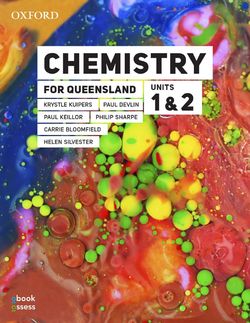Limited Stock Available!
The new Queensland Senior Chemistry syllabus (to be implemented from 2019) will affect all aspects of teaching and learning – new teaching content, new course structure and a new approach to assessment. As Secondary Publisher of the Year 2017, Oxford University Press is committed to helping teachers and students in Queensland reach their full potential.
Chemistry for Queensland provides depth and complete coverage of the new syllabus in a format that offers extensive support for teachers and their students. This new two-volume edition covers Units 1 & 2 (Book 1, publishing in 2018), and Units 3 & 4 (Book 2, publishing in 2019).
Key features include:
A Chemistry Toolkit which is a stand-alone reference section that explains the structure of the syllabus, supports the acquisition of key skills and provides practical tips for success in Chemistry A Practical Manual which outlines suggested methodologies for every mandatory practical in the syllabus. Learning pathways which are clearly mapped directly to the syllabus to ensure complete coverage Assessment support and resources which include exam preparation and practice Coverage of key subject matter which is presented using clear, concise language supported by engaging visual elements and sequenced to scaffold student learning Differentiated teaching which is supported by a range of appropriately levelled questions and activities for each section Inquiry learning and critical thinking approaches which are clearly modelled throughout Additional digital learning resources which support teachers and students.
CONTENTS:
CHAPTER 1: Chemistry toolkit
UNIT 1
CHAPTER 2: Atom structure and the Periodic Table
CHAPTER 3: Introduction to bonding
CHAPTER 4: Isotopes
CHAPTER 5: Analytical techniques
CHAPTER 6: Compounds and mixtures
CHAPTER 7: Bonding and properties
CHAPTER 8: Chemical reactions
CHAPTER 9: Measurement uncertainty and error
CHAPTER 10: Fuels
CHAPTER 11: Mole concept and law of conservation of mass
Unit 1 Practice exam questions
UNIT 2
CHAPTER 12: Intermolecular forces
CHAPTER 13: Chromatography techniques
CHAPTER 14: Gases
CHAPTER 15: Aqueous solutions and molarity
CHAPTER 16: Solubility and Identifying ions in solution
CHAPTER 17: pH
CHAPTER 18: Reaction of acids
CHAPTER 19: Rates of chemical reactions
Unit 2 Practice exam questions
CHAPTER 20: Practical manual















